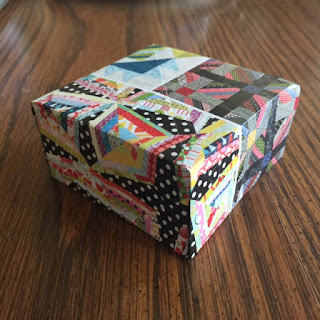 |
| Folded box made of pages from Fons & Porter "Scrap Quilting". |
I have been making these Origami boxes for a very long time. They are beautiful and elegant and very easy to fold. Start with two squares of paper of any size and by making the box twice, you have both top and bottom that fit easily inside each other.
The Fons and Porter Love of Quilting TV series featured a box made of pages from a quilting magazine in the "Tips" section of program # 3001 titled "Diagonally Set Log Cabin Quilts". I thought this would be an excellent way to highlight these wonderful little paper boxes that are such a pleasure to create.
There is a very good video of how to create this box at "Classic Origami Box" on Instructables.com, and "Easy Origami Open Box".
I have shown my process here with a page from the Fons & Porter special bonus issue, "Scrap Quilts". I have developed a simple mnemonic to help me remember how to make this box. I say, "Make a blintz, and put it in the cupboard." Once you have done the blintz fold and the cupboard fold, you unfold the ends of the box and refold them into a 3-D configuration that creates the box.
When this is done, put a piece of tape on the spot where the points come together and you have a very nice gift box, or trinket holder.
How to make an origami box
Cut a square of paper from a quilting magazine page. An 8.5-inch square will make a 3-inch square box, 1.5-inches deep. Fold the square in half in both directions to determine the center point of the paper. Once the center point has been determined, fold each corner of the paper into the center point to make a configuration that resembles a blintz pastry.
Making the blintz.
Completed blintz fold.
Fold the blintz in half, both horizontally . . .
. . . and vertically.
Then fold each edge into the center of the blintz to create a cupboard door on the left . . .
. . . and the right -- closing both cupboard doors on the blintz.
Open the cupboard doors and pull out the ends of the construction.
 |
| Push in the corners and fold the point of one end into the center of the box. |
One end is folded.
Repeat on both ends of the box.
Tape the center points, to hold in position.
Make two boxes of the same size and carefully fit one box inside the other to make a box top and box bottom.









Comments